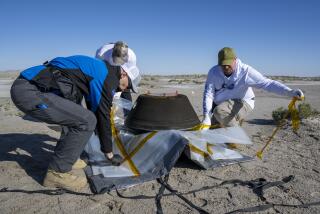‘It was just like we practiced’: New Horizons’ flawless Pluto flyby
- Share via
It’s official: New Horizons has survived its close flyby of the Pluto system unscathed.
“We have a healthy spacecraft, we have a healthy system, and we are outbound for Pluto,” Alice Bowman, mission operations manager for New Horizons, said Tuesday night after the first group of ones and zeros arrived at the Johns Hopkins Applied Physics Laboratory in Laurel, Md., which is managing the mission for NASA.
“It was just like we practiced,” she said.
------------
FOR THE RECORD:
New Horizons mission: In the July 13 Section A, the headline for an article about NASA’s New Horizons spacecraft referred to its rendezvous “across the galaxy” with Pluto. It has flown across the solar system. —
------------
The mission team had waited a long time for this moment.
“It’s been 9 1/2 years, but this is the payday,” said Hal Weaver, New Horizons project scientist. “We flew 7,500 miles above the surface of Pluto, 3 billion miles from home.”
New Horizons’ long journey to Pluto culminated Tuesday morning, when the NASA spacecraft went screaming past the dwarf planet at 30,800 mph. But the mission is far from over.
Even as the spacecraft speeds deeper into the Kuiper belt, where Pluto resides, its instruments will continue to search for signs of faint rings around Pluto and take measurements of the dust and plasma in the dwarf planet’s neighborhood.
And then there are all the new data the spacecraft has to send back to Earth.
New Horizons had stopped communicating with ground control at 8:17 p.m. Pacific time Monday. Since the flyby window was so brief, mission architects wanted all of New Horizons’ power to be focused on data collection, not checking in with Earth.
Even so, the loss of contact was nerve-racking for the mission team.
“There’s nothing like a safe-mode event to sharpen one’s senses,” said John Grunsfeld, NASA’s science mission chief.
Bowman admitted that by Tuesday afternoon her anxiety level was soaring.
“I did some more data checks once, twice, maybe a hundred times,” she said.
The spacecraft resumed contact with Earth at 5:52 p.m. Pacific time, about 10 minutes ahead of schedule.
The first batch of observational data from the flyby will start to arrive at 2:32 a.m. Wednesday, and it will include the highest-resolution images taken by the spacecraft. These black-and-white pictures will be 10 times more detailed than the best images released so far.
“They will dazzle us,” said Glenn Fountain, project manager on the mission.
But that’s not why they’re being sent first.
“These are the images that we will get the most science from, and we want it to be the first to come down,” said Henry Throop, a scientist on the New Horizons team.
The data will be received by one of three 70-meter antennas in NASA’s Deep Space Network, but the information will arrive at a slow trickle of just 1,000 to 4,000 bits per second. That’s about the speed of a computer modem from 20 years ago, Throop said.
New Horizons will continue to send the highest-priority images in a compressed state for the next two weeks. In August it will start sending raw data back to Earth for eight hours a day. Mission scientists say it will take 16 months to get everything off the spacecraft.
“Scientifically, this will be the data set for Pluto that we will have for decades,” Throop said. “We are not going back to Pluto anytime soon.”
But even when New Horizons has nothing more to tell us about the dwarf planet and its immediate environment, its work may not be over.
Alan Stern, New Horizons’ principal investigator, is hopeful that the spacecraft will journey to another object in the Kuiper belt — one that is closer in size to the comets that zip through our solar system.
The New Horizons team will work with NASA to choose among three potential Kuiper belt objects to send the spacecraft to next, and possibly fire its engines to point it in the right direction. All three candidates are another billion miles beyond Pluto, and it would take New Horizons two or three years to reach one of them.
The spacecraft is powered by plutonium, and it has enough left to keep it operational through the mid-2030s, Stern said.
Even after a visit to a second object, the mission could still have legs.
“We could send it to a planetesimal” — a much smaller object — “and then have it explore the deep regions of the heliosphere,” the immense magnetic bubble enveloping the solar system, Stern said. “It would be like Voyager, but with much more modern instruments.”
Science rules! Follow me @DeborahNetburn and “like” Los Angeles Times Science & Health on Facebook.







